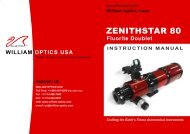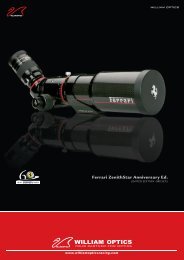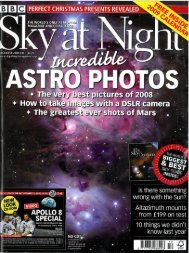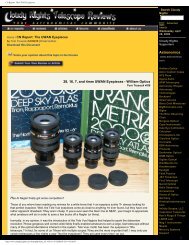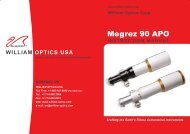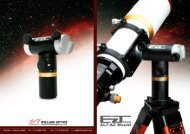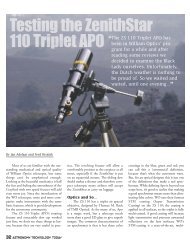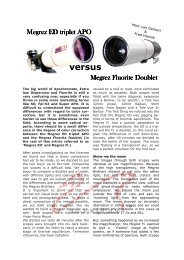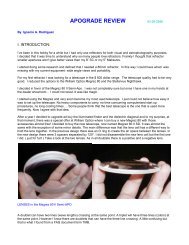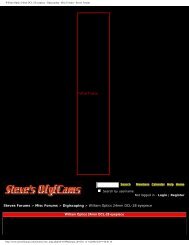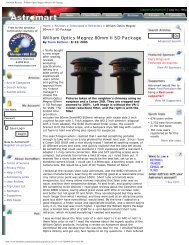Telescope Reviews: William Optics 7x50 ED binocular minireview
Telescope Reviews: William Optics 7x50 ED binocular minireview
Telescope Reviews: William Optics 7x50 ED binocular minireview
- No tags were found...
Create successful ePaper yourself
Turn your PDF publications into a flip-book with our unique Google optimized e-Paper software.
<strong>Telescope</strong> <strong>Reviews</strong>: <strong>William</strong> <strong>Optics</strong> <strong>7x50</strong> <strong>ED</strong> <strong>binocular</strong> <strong>minireview</strong>Accurate measuring of sharpness of image across the field of view showedsome problems. The sharpness is not balanced. 16 Cygni, a 6.0-6.1/39”double star could be seen clearly separated out to 90% of the field on theright side. However on the left side of the view, it became distorted beyondperception at 70% out from center. Both barrels produced the same error.The same error was noticed when observing the USAF resolution bar charts.The right barrel shows some minor amount of astigmatism. This was seen onaxisas a bright star was defocused inside and outside of focus. Theorientation of the out-of-focus image would flip 90° as I passed thru theprecise focus point.The <strong>binocular</strong> is stated as waterproof / shockproof. I can say that it seemsvery ruggedly built. I did not attempt a water immersion test. I appreciatewaterproof <strong>binocular</strong>s since I often leave my equipment out overnight. Quiteoften, I find my equipment completely soaked with morning dew. I never gettoo concerned about my waterproof equipment, but always need to protect<strong>binocular</strong>s such as the Nikon SE.This <strong>binocular</strong> uses some combination of <strong>ED</strong> glass. Chromatic Aberration isvery well suppressed. I could not produce any false color on anyastronomical objects anywhere in the field of view, including mag1 stars,mag –1.7 Mars and the near full moon. Also I could not produce any falsecolor in daylight when viewing the edges of white porch posts in sunlight orwhen viewing sunlit tree limbs against a bright blue sky background.Internal baffling is flat gray/black ridges in the barrels. I could not produceany ghosting or internal reflections with the moon off axis or just out of theedge of the field of view.The <strong>binocular</strong> is complete wrapped in a 1.2mm thick rubber coated armor.The rubber armor is brown.Collimation of star points was not seen to be in error by more than a verysmall amount, well within standards and easily merged. Collimation of thefield overlap is off by several arcminutes. It is more noticeable in daylightviewing, where I would say field overlap is off by 10 to 12 inches at 200 feet.That represents about 15 arcminutes, or 3% of the field. There are noexternally accessible prism adjustment screws found under the rubberarmor.The IPD hinge is solidly stiff and very smooth. The eyepieces likewise aresolidly stiff, but move with a quiet smoothness. Nothing moves unless youintend to move it.Night-sky observing impressions show a very clear bright view. At 7x, notmuch detail can be seen, but that impression is from one who spends a lot oftime behind 16x70, 20x80, 25x100 and even 30x-40x100 <strong>binocular</strong>s. So Ican’t very well compare this 7x <strong>binocular</strong> to some of the star counts I’vedone or to the density seen in clusters like the double cluster at 20x or 25x.I did find one particular object of interest last night. The moon was justhttp://www.cloudynights.com/ubbthreads/showflat.php/Cat/0/Number/694293/page/0/view/collapsed/sb/5/o/all/fpart/1/vc/1 (3 of 22)2006/4/26 •• 04:44:56



